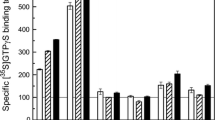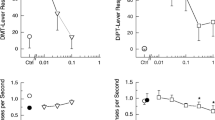Summary
The characteristics of high affinity [3H]5-HT (5-hydroxytryptamine) binding to non 5-HTIA non 5-HT1A sites were examined in crude membranes prepared from different regions of guinea-pig and pigeon brains. The coupling of these sites to adenylate cyclase was examined, and its pharmacological profile investigated. In the presence of 100 nmol/1 8-OH-DPAT (8-hydroxy-2-(di-n-propylamino)tetralin) and 100 nmol/l mesulergine, [3H]5-HT labelled with nanomolar affinity an apparently homogeneous population of recognition sites in guinea-pig and pigeon brain membranes. The rank order of affinities of agonists and antagonists (5-CT (5-carboxamidotryptamine) > 5-HT > RU 24969 pyridinyl)-1H indole succinate) > yohimbine ≥ rauwolscine > DP-5-CT (N,N dipropyl-5-carboxamidotryptamine) ≥ mianserin > 8-OH-DPAT > mesulergine > SDZ 21-009 ((±)-4(3-tert-butyl-amino-2-hydroxypropoxy)-in-dol-2 carbonic acid isopropyl ester) > (-)propranolol), as well as their individual pKD values, were very similar to those at porcine caudate 5-HT1D sites and clearly different from those at rat cortex 5-HT1B sites. In the substantia nigra of the guinea-pig the 5-HT receptor-mediated inhibition of forskolin-stimulated adenylate cyclase had a pharmacological profile fully comparable to that of 5-HT1D binding sites (5-CT > 5-HT > yohimbine > RU 24969 > 8-OH-DPAT > SDZ 21-009 = isamoltane > (−)pindolol > (−)propranolol). The rank order of potency of agonists and antagonists in this system closely paralleled their corresponding rank order of potency in the calf substantia nigra (5-HT1D), but was clearly different from that in rat substantia nigra (5-HT1B) These results demonstrate the existence of 5-HT1D recognition sites in the guinea-pig and pigeon brain and their similarity to 5-HT1D sites of higher mammals, in terms of both drug affinity profile and second messenger coupling. No evidence of the presence of 5-HTIB sites was obtained. The present findings also suggest that 5-HT1D sites may be present in the brain of the majority of vertebrate species located higher than the sauropside-mammalian divergence in the phylogenic tree, whereas 5-HT1B sites are only found in some (e.g., mouse, rat, hamster) but not in other rodents (e.g. guinea-pig).
Similar content being viewed by others
References
Barnes NM, Costall B, Naylor RJ (1988) [3H]Zacopride: Ligand for the identification of 5-HT3 recognition sites. J Pharm Pharmacol 40: 548–551
Bouhelal R, Smounya L, Bockaert J (1988) 5-HT18 receptors are negatively coupled with adenylate cyclase in rat substantia nigra. Eur J Pharmacol 151:189–196
Bradford MM (1976) A rapid and sensitive method for the quantitation of micrograms quantities of protein utilizing the principle of protein-dye binding. Anal Biochem 72:248–254
Bradley PB, Engel G, Feniuk W, Fozard JR, Humphrey PPA, Middlemiss DN, Mylecharane EJ, Richardson BP, Saxena PR (1986) Proposals for the classification and nomenclature of functional receptors for 5-hydroxytryptamine. Neuropharmacology 25: 563–576
De Lean A, Stadel JM, Lefkowitz RJ (1980) A ternary complex model explains the agonist-specific binding properties of the adenylate cyclase-coupled β-adrenergic receptor. J Biol Chem 255:7108–7117
Fargin A, Raymond JR, Lohse MJ, Kobilka BK, Caron MC, Lefkowitz RJ (1988) The genomic clone G-21 which resembles a \-adrenergic receptor sequence encodes the 5-HTIA receptor. Nature 335:358–360
Furchgott RF (1972) The classification of adrenoceptors(adrenergic receptors). An evaluation from the standpoint of receptor theory In: Blaschko H, Muscholl E (eds) Catecholamines. Springer, Berlin Heidelberg New York, p 283–335
Gozlan H, El Mestikawy S, Pichat L, Glowinski J, Hamon M (1983) Identification of presynaptic serotonin autoreceptors using a new ligand: [3H]PAT. Nature 305:140–142
Heuring RE, Peroutka SJ (1987) Characterization of a novel 3H-5hydroxytryptamine binding site subtype in bovine brain membranes. J Neurosci 7:894–903
Heuring RE, Schlegel JR, Peroutka SJ (1986) Species variations in RU 24969 interactions with non 5-HT1A binding sites. Eur J Pharmacol 122:279–282
Hoyer D, Middlemiss DN (1989) The pharmacology of the terminal 5-HT autoreceptors in mammalian brain: evidence for species differences. Trends Pharmacol Sci 10:130–132
Hoyer D, Neijt HC (1988) Identification of serotonin 5-HT3 recognition sites in membranes of NIE-115 neuroblastoma cells by radioligand binding. Mol Pharmacol 33:303–309
Hoyer D, Engel G, Kalkman HO (1985a) Characterization of the 5-HTIB recognition site in rat brain: binding studies with (−)-[125I]iodocyanopindolol. Eur J Pharmacol 118:1–12
Hoyer D, Engel G, Kalkman HO (1985b) Molecular pharmacology of 5-HT1 and 5-HT2 recognition sites in rat and pig brain membranes: radioligand binding studies with [3H]5-HT, [3H]8-OH-DPAT, (−)[125I]iodocyanopindolol. [3H]mesulergine and [3H]ketanserin. Eur J Pharmacol 118:13–23
Hoyer D, Pazos A, Probst A, Palacios JM (1986) Serotonin receptors in the human brain: I Characterization and autoradiographic localization of 5-HT1A recognition sites. Apparent absence of 5-HT1B recognition sites. Brain Res 376:85–96
Hoyer D, Waeber C, Pazos A, Probst A, Palacios JM (1988) Identification of a 5-HT1 recognition site in human brain membranes different from 5-HT1A, 5-HT1B and 5-HT1c sites. Neurosci Lett 85:357–362
Julius D, MacDermott AB, Axel R, Jessell TM (1988) Molecular characterization of a functional cDNA encoding the serotonin 1c receptor. Science 241:558–564
Kenakin TP (1984) The classification of drugs and drug receptors in isolated tissues. Pharmacol Rev 36:165–222
Kilpatrick GJ, Jones BJ, Tyers MB (1987) Identification and distribution of 5-HT3 receptors in rat brain using radioligand binding. Nature 330:746–748
Kobilka BK, Frielle T, Collins S, Yang-Feng T, Kobilka TS, Francke U, Lefkowitz RJ, Caron M (1987) An intronless gene encoding a potential member of the family of receptors coupled to guanine nucleotide regulatory proteins. Nature 329:75–79
Leysen JE, Niemegeers CJE, Van Nueten JM, Laduron PM (1982) [3H]Ketanserin (R 41468), a selective [3H]-ligand for serotoni2 receptor binding sites. Mol Pharmacol 21:301–314
Lübbert H, Snutch T, Dascal N, Lester HA, Davidson N (1987) Rat brain 5-HT1C receptors are encoded by a 5–6 kb mRNA size class and functionally expressed in injected Xenopus Oocytes. J Neurosci 4:1159–1165
Pazos A, Palacios JM (1985) Quantitative autoradiographic mapping of serotonin receptors in the rat brain: I Serotonin-1 receptors. Brain Res 346:205–230
Pazos A, Hoyer D, Palacios JM (1984) The binding of serotoninergic ligands to porcine choroid plexus: Characterization of a new type of serotonin recognition site. Eur J Pharmacol 106:539–546
Pazos A, Probst A, Palacios JM (1987) Serotonin receptors in the human brain. III Autoradiographic mapping of serotonin-1 receptors. Neuroscience 21:97–122
Pazos A, Hoyer D, Died MM, Palacios JM (1988) Autoradiography of serotonin receptors In: Osborne NN, Hamon M (eds) Neuronal serotonin. Wiley, New York, pp 507–543
Peroutka SJ (1988) 5-hydroxytryptamine receptor subtypes: Molecular, biochemical and physiological characterization. TINS 11:496–500
Peroutka SJ, Hamik A (1988) [3H]Quipazine labels 5-HT3 recognition sites in rat cortical membranes. Eur J Pharmacol 148:297–299
Peroutka SJ, Snyder SH (1979) Multiple serotonin receptors: differential binding of [su3H]-5-hydroxytryptamine, [3H]lysergic acid diethylamide and [3H]-spiroperidol. Mol Pharmacol 16:687–699
Pritchett DB, Bach AWJ, Wozny M, Taleb O, Dal Toso R, Shih JC, Seeburg PH (1988) Structure and functional expression of cloned rat serotonin 5-HT2 receptor. EMBO J 7:4135–4140
Salomon Y, Londos C, Rodbell M (1974) A highly sensitive adenylate cyclase assay. Anal Biochem 58:541–548
Scatchard G (1949) Attraction of proteins for small molecules and ions. Ann N Y Acad Sci USA 51:660–679
Schoeffter P, Hoyer D (1989a) Interaction of arylpiperazines with 5-HT1A, 5-HT1B, 5-HT1C and 5-HT1D receptors: do discriminatory 5-HT1B receptor ligands exist? Naunyn-Schmiedeberg's Arch Pharmacol 339:675–683
Schoeffter P, HoyerD (1989b) tFurther pharmacological characterization and comparison of 5-HTIB and 5-HT1D receptor-mediated inhibition of adenylate cyclase activity in rat and calf substantia nigra. Naunyn-Schmiedeberg's Arch Pharmacol 340: in press
Schoeffter P, Waeber C, Palacios JM, Hoyer D (1988) The 5-hydroxytryptamine 5-HT1D receptor subtype is negatively coupled to adenylate cyclase in calf substantia nigra. Naunyn-Schmiedeberg's Arch Pharmacol 337:602–608
Waeber C, Dietl MM, Hoyer D, Probst A, Palacios JM (1988a) Visualization of a novel serotonin recognition site 5-HT1D in the human brain by autoradiography. Neurosci Lett 88: 11–16
Waeber C, Dixon K, Hoyer D, Palacios JM (1988b) Localisation by autoradiography of neuronal 5-HT3 receptors in the mouse CNS. Eur J Pharmacol 151: 351–352
Waeber C, Schoeffter P, Palacios JM, Hoyer D (1988 c) Molecular pharmacology of 5-HT1D recognition sites: radioligand binding studies in human, pig and calf brain membranes. Naunyn-Schmiedeberg's Arch Pharmacol 337:595–601
Waeber C, Dietl MM, Hoyer D, Palacios JM (1989) 5-HT1 receptors in the vertebrate brain: regional distribution examined by autoradiography. Naunyn-Schmiedeberg's Arch Pharmacol 340:486–494
Author information
Authors and Affiliations
Rights and permissions
About this article
Cite this article
Waeber, C., Schoeffter, P., Palacios, J.M. et al. 5-HT1D receptors in guinea-pig and pigeon brain. Naunyn-Schmiedeberg's Arch Pharmacol 340, 479–485 (1989). https://doi.org/10.1007/BF00260601
Received:
Accepted:
Issue Date:
DOI: https://doi.org/10.1007/BF00260601




